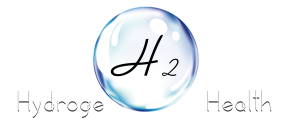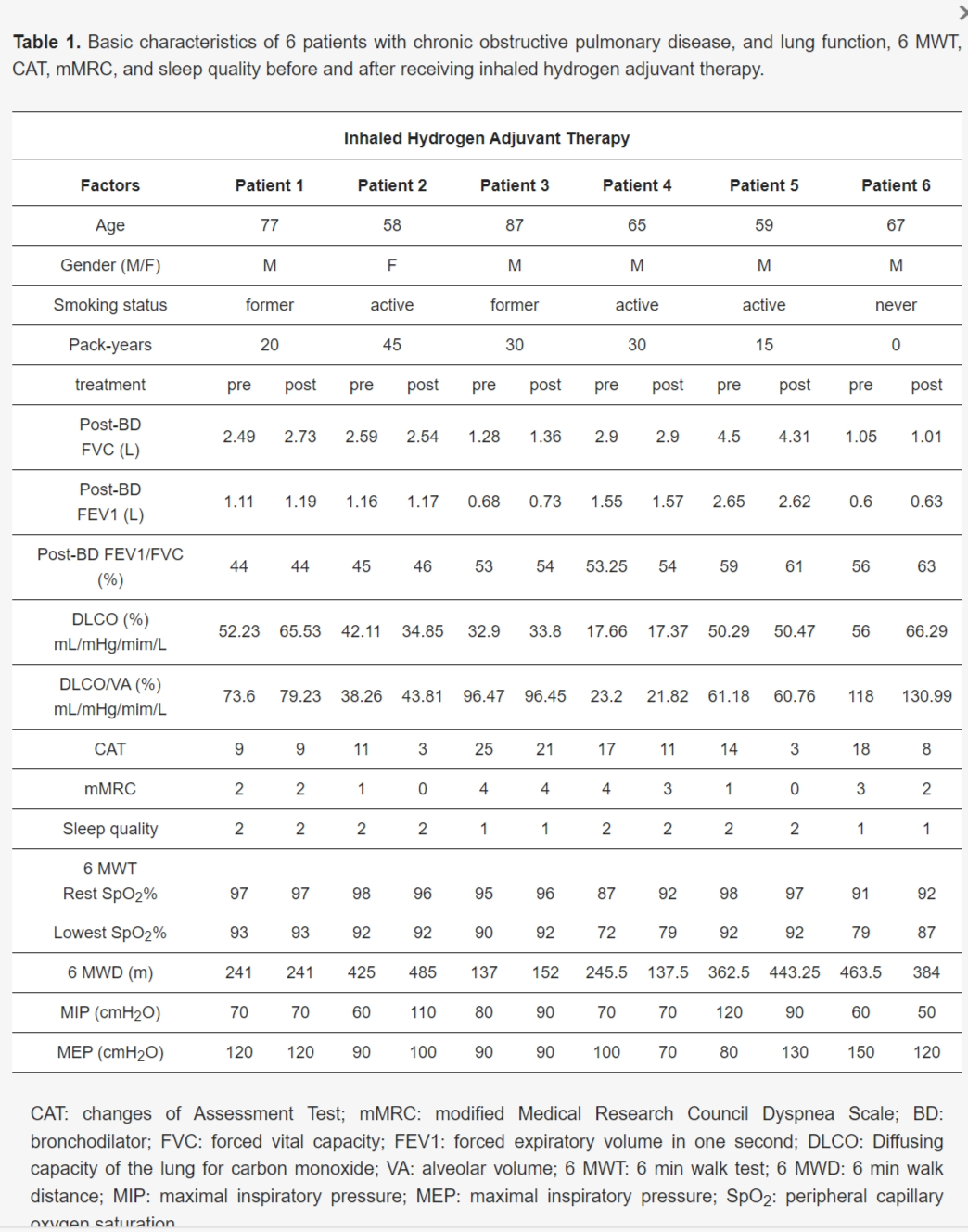Natural Healthy

Natural Healthy

Background and Objectives: Recent studies have suggested that hydrogen gas possesses anti-inflammatory, antioxidant, and anti-apoptotic properties. This study aimed to explore the therapeutic potential of hydrogen gas and evaluate its safety and tolerability in patients with chronic obstructive pulmonary disease (COPD). Materials and Methods: COPD patients were enrolled to receive standard treatment along with additional inhalation of hydrogen gas for 30 minutes each morning, afternoon, and evening within 30 days. Assessment included Chronic Obstructive Pulmonary Disease Assessment Test (CAT), Modified Medical Research Council (mMRC) dyspnea scale, pulmonary function, sleep quality, inflammatory markers, and changes in oxidative stress markers before and after hydrogen gas inhalation. Results: Six patients participated in the study. Patients 2, 3, 4, 5, and 6 showed improvements in CAT scores after hydrogen gas intervention, and patients 2, 4, 5, and 6 also showed improvement in mMRC scores. Statistically, the study demonstrated significant improvements in CAT [15.5 (10.5-19.75) to 8.5 (3-13.5); p = 0.043] and mMRC scores [2.5 (1-4) to 2 (0-3.25); p = 0.046] before and after intervention. However, no significant differences were observed in pulmonary function, DLCO, sleep quality, and 6MWT before and after hydrogen gas therapy. Complete blood cell count showed a significant difference in platelet count before and after treatment [247 (209.75-298.75) vs. 260 (232.75-314.5); p = 0.043], while other blood tests, inflammatory markers, and oxidative stress markers showed no significant differences before and after hydrogen gas treatment. All patients had no significant adverse effects. Conclusion: Hydrogen gas adjunctive therapy demonstrated symptom improvement in specific COPD patients without significant adverse reactions observed in any patient. Hydrogen gas may also have a regulatory effect on platelet count.
Reference: Liu S-F, Li C-L, Lee H-C, Chang H-C, Liu J-F, Kuo H-C. The Benefit of Hydrogen Gas as an Adjunctive Therapy for Chronic Obstructive Pulmonary Disease. Medicina. 2024; 60(2):245.
1. Introduction
Chronic obstructive pulmonary disease (COPD) is a progressively debilitating respiratory condition characterized by chronic bronchitis and emphysema, leading to breathing difficulties and impaired lung function. As a significant global health concern, COPD affects millions worldwide, resulting in significant morbidity and mortality. The pathogenesis of COPD involves oxidative stress and inflammation, and recent research has unveiled the potential benefits of hydrogen gas. Hydrogen gas is renowned for its antioxidant and anti-inflammatory properties, demonstrating potential in alleviating COPD in both preclinical and clinical settings.
The anti-inflammatory and antioxidant effects of hydrogen gas are attributed to its ability to target reactive oxygen species (ROS) and inhibit the activation of NLRP3 inflammasomes in macrophages. Additionally, hydrogen gas plays a role in modulating the expression of genes associated with oxidative stress and inflammation, including heme oxygenase-1 and nuclear factor-kappa B (NF-κB). It also regulates the levels of inflammatory cytokines and chemokines by inhibiting the activation of the transcription factor NF-κB, such as interleukin-1β (IL-1β), interleukin-6 (IL-6), and tumor necrosis factor alpha (TNF-α). Furthermore, hydrogen gas modulates the expression of antioxidant enzymes such as superoxide dismutase (SOD) and catalase, providing protection against oxidative stress-induced damage.
Current treatments for COPD primarily focus on symptom reduction, improving lung function, and preventing exacerbations. However, there is growing interest in exploring new therapeutic interventions to further alleviate symptoms, slow disease progression, and enhance the quality of life for patients. One promising avenue is investigating the potential of hydrogen gas as a therapeutic intervention for COPD. This emerging research holds the potential to open new doors for the development of innovative approaches to managing COPD, offering hope for improved outcomes and better quality of life for affected individuals.
2. Materials and Methods
2.1 Study Design
Between July 1, 2021, and June 30, 2023, we recruited COPD patients from the outpatient department of Kaohsiung Chang Gung Memorial Hospital who expressed willingness to participate in this research project. These patients had previously received standard treatments according to the GOLD guidelines (i.e., SABA/LABA medication, corticosteroids/other drugs, or long-term oxygen therapy) and were clinically stable. Upon enrollment, they commenced a 30-day course of hydrogen gas inhalation therapy at home. This study aimed to investigate the synergistic effects of adjunctive hydrogen gas inhalation in COPD and evaluate its safety and tolerability. Assessment parameters included changes in COPD assessment test (CAT), modified Medical Research Council (mMRC) dyspnea scale, lung function, sleep quality, inflammatory markers, and free radicals before and after the 30-day treatment period.
A. Inclusion Criteria (all criteria must be met):
B. Exclusion Criteria:
2.2. Hydrogen Gas Inhalation
Patients receiving adjunctive hydrogen gas inhalation therapy were treated at home using a hydrogen-oxygen machine, with sessions lasting 30 minutes each in the morning, afternoon, and evening (totaling 90 minutes per day). Patients inhaled a mixture gas containing 73% hydrogen and 27% oxygen through a nasal cannula, with a flow rate set at 70-75 liters per hour. If any abnormal respiratory, heart rate, blood oxygen, or blood pressure readings occurred during the use of the hydrogen-oxygen machine, or if the patient was unable to cooperate, or if termination of the trial was requested for any reason (at the patient's request), the treatment was immediately discontinued.
2.3. Equipment and Explanation of Possible Side Effects
In this study, we utilized the EIOXY Machine HB-133 model provided by EPOCH ENERGY TECHNOLOGY CORP (Kaohsiung, Taiwan). The machine operates on AC power (110V, 50/60Hz) with a maximum power consumption of 0.35kW. It operates at a non-accumulated working pressure of 0 kg/cm², with a maximum water consumption of 25±5 c.c. per cycle. The machine, excluding accessories, weighs 38.5 kilograms and has dimensions of 36×35×62 centimeters. Clearance of 10 centimeters is required around the front, back, left, right, and top. The machine produces an airflow of 70-75 liters per hour (approximately 1.25 liters per minute), consisting of 73% hydrogen and 27% oxygen, sufficient to meet the normal respiratory needs of humans. Extensive research and numerous papers have consistently confirmed that this combination of hydrogen and oxygen does not cause side effects. The main consideration is to prevent nasal dryness when using the nasal cannula for inhalation. In extremely rare cases, abrasion of the nasal skin may result in minor nasal bleeding. However, this issue can be effectively addressed by adjusting the length of the nasal cannula to minimize its occurrence.
2.4. Clinical and Laboratory Variables
Clinical and laboratory variables were assessed before and after 30 days of adjunctive hydrogen gas inhalation therapy, including CAT and mMRC scores; sleep quality; lung function tests; diffusing capacity of the lungs for carbon monoxide (DLCO); 6-minute walk test (6MWT); complete blood cell count and differential count; oxidative stress markers (plasma glutathione peroxidase (GPX), myeloperoxidase (MPO), total antioxidant capacity (TAC), urine 8-hydroxy-2'-deoxyguanosine (8-OHdG)); lipid profile (total cholesterol (T-CHO), high-density lipoprotein (HDL), low-density lipoprotein (LDL), triglycerides (TG)).
2.5. Statistical Analysis
Continuous variables were presented as median and interquartile range (IQR). All objective and subjective data were recorded before and after adjunctive hydrogen gas inhalation therapy. Wilcoxon signed-rank tests were used to evaluate changes in lung function, 6MWT, CAT, mMRC, Borg scale, inflammatory markers, and free radicals before and after treatment. Calculations were performed using SPSS 26, with a defined p-value < 0.05 indicating significant differences.
3. Results
Patient characteristics and baseline conditions of hydrogen gas inhalation therapy are presented in Table 1.
The basic characteristics of the six patients with chronic obstructive pulmonary disease (COPD) who received adjunctive hydrogen gas inhalation therapy are shown in Table 1. The study included six participants, five of whom were male and one female, with an average age of 68 years. Five participants had a history of smoking, ranging from 15 to 45 pack-years, while one participant had never smoked. The mean post-bronchodilator FEV1/FVC ratio was 49.8%. The severity of COPD was classified as severe for Patient 1 and moderate for the other five patients (Table 1).

Following hydrogen gas inhalation intervention, Patients 2, 3, 4, 5, and 6 showed improvements in CAT scores, and Patients 2, 4, 5, and 6 also demonstrated improvements in mMRC scores (Table 1). Statistically, the study demonstrated significant improvements in CAT [15.5 (10.5–19.75) vs. 8.5 (3–13.5); p = 0.043] and mMRC scores [2.5 (1–4) vs. 2 (0–3.25); p = 0.046] before and after hydrogen gas inhalation therapy (Table 2, Figure 1). However, no significant differences were observed in lung function, DLCO, sleep quality, and 6MWT before and after hydrogen gas therapy (Table 1). CBC examination revealed a significant difference in platelet count before and after treatment [247 (209.75–298.75) vs. 260 (232.75–314.5); p = 0.043] (Table 3, Figure 2), while other blood tests, inflammatory markers, and oxidative stress markers showed no significant differences before and after hydrogen gas therapy (Table 3).